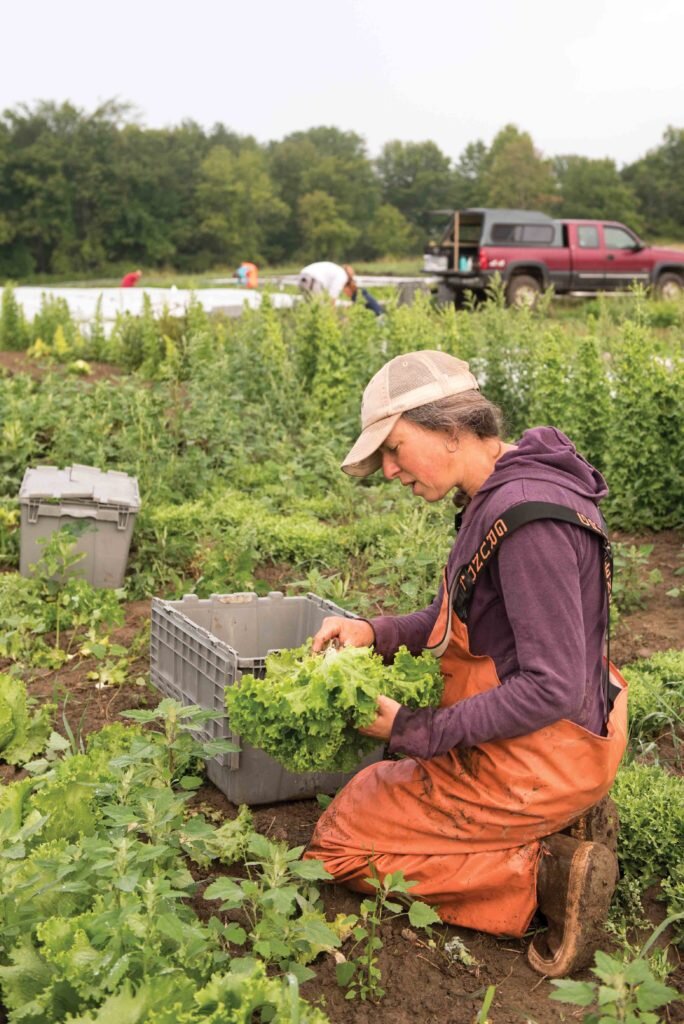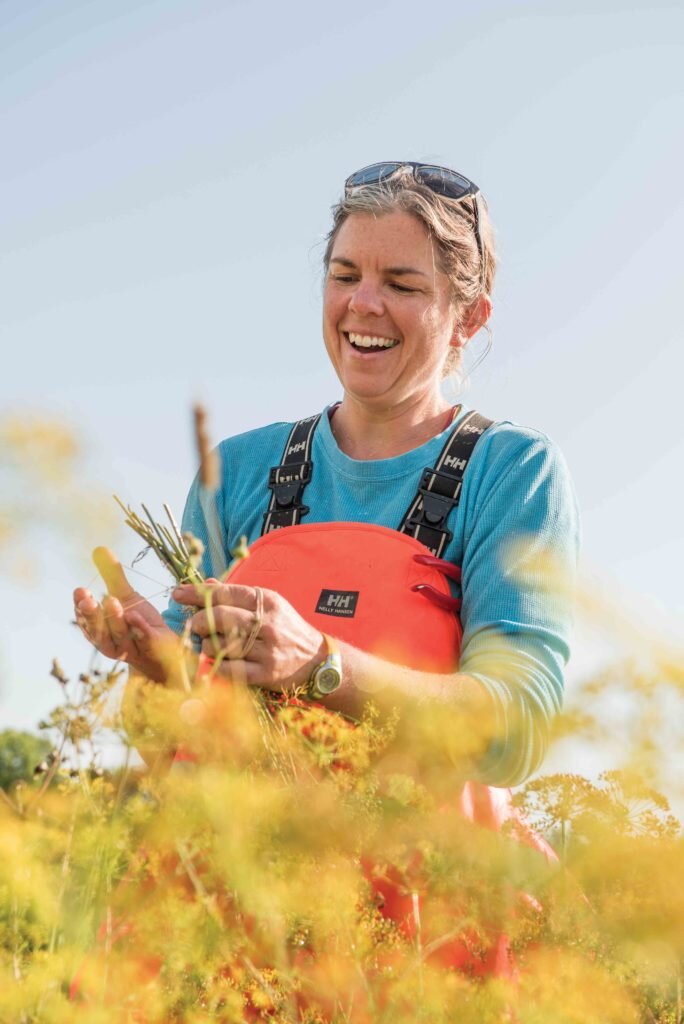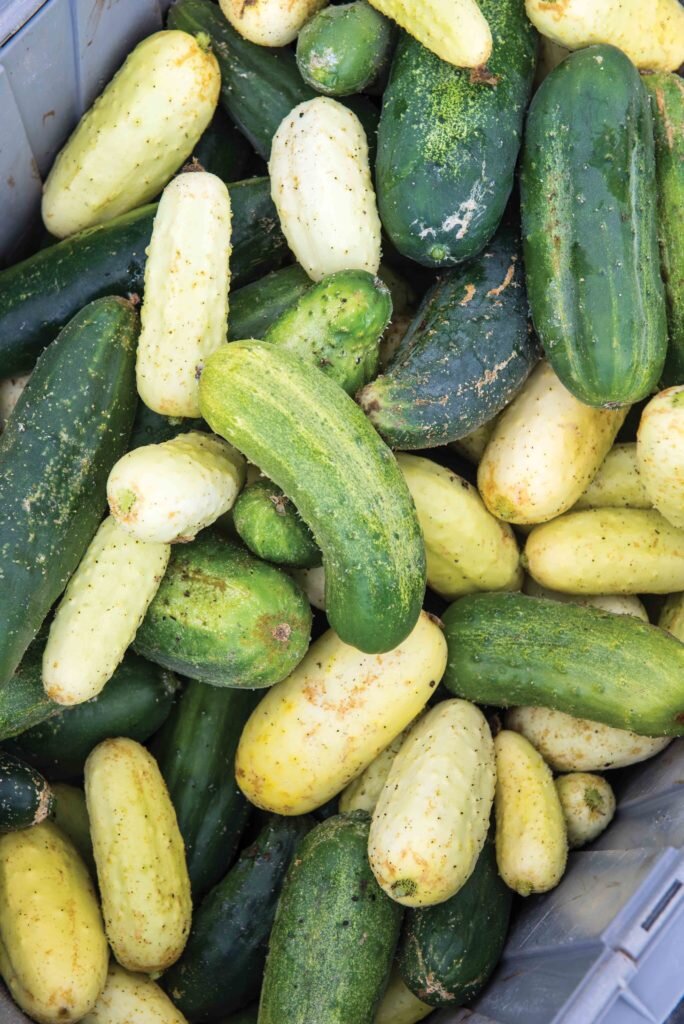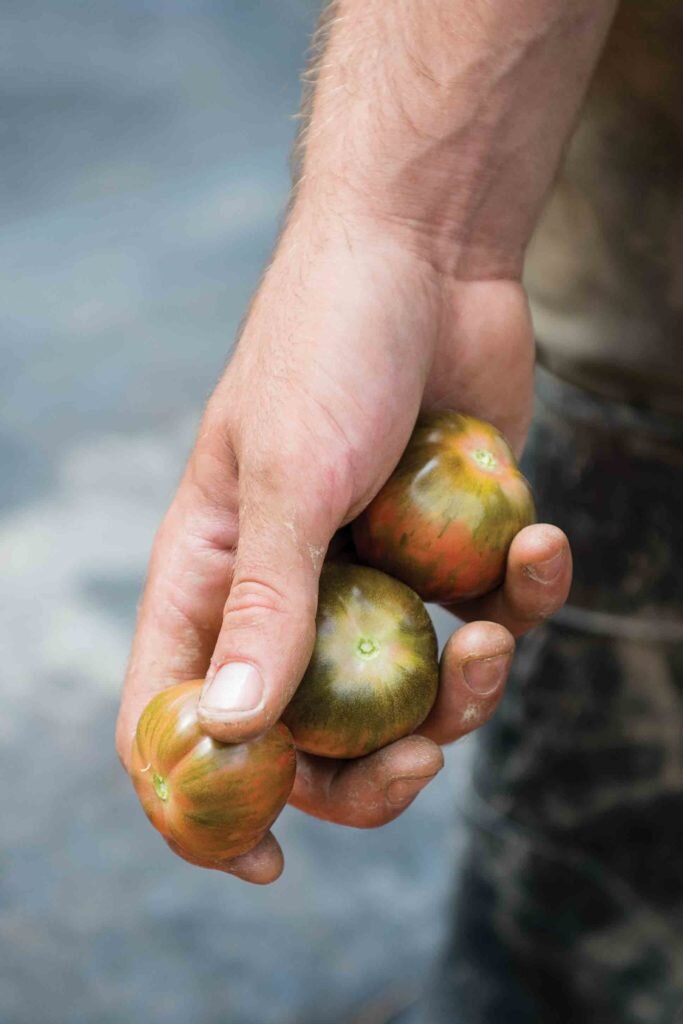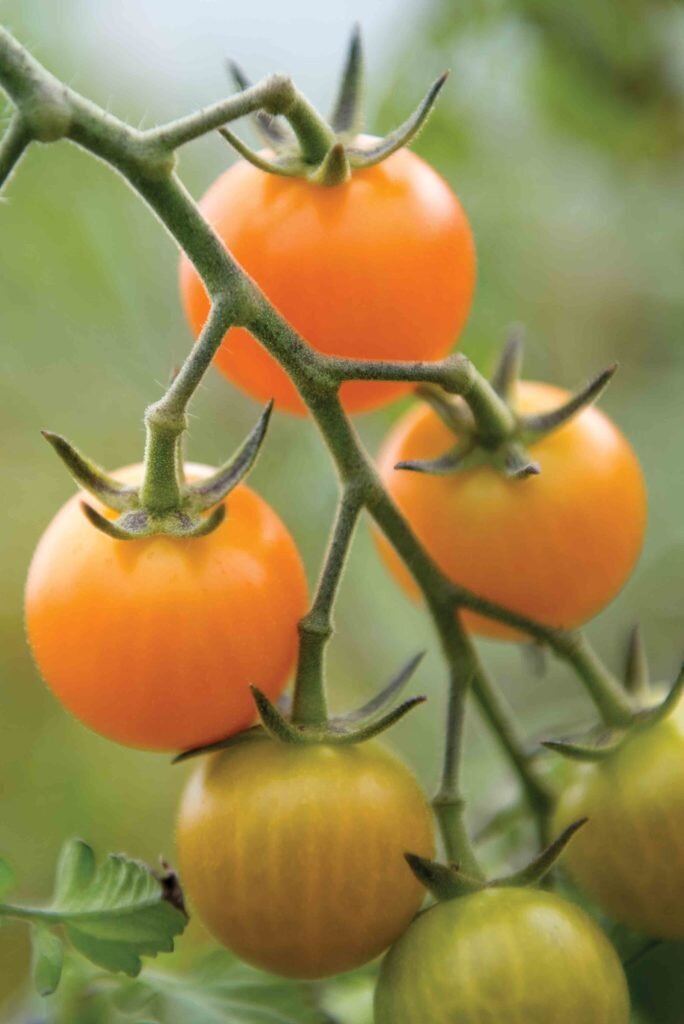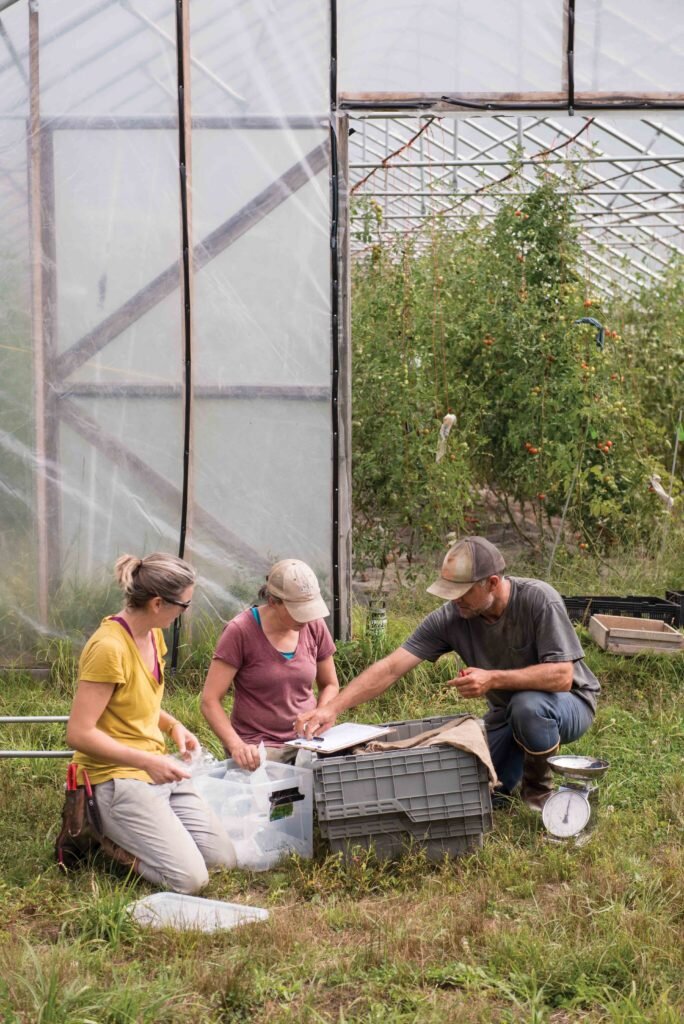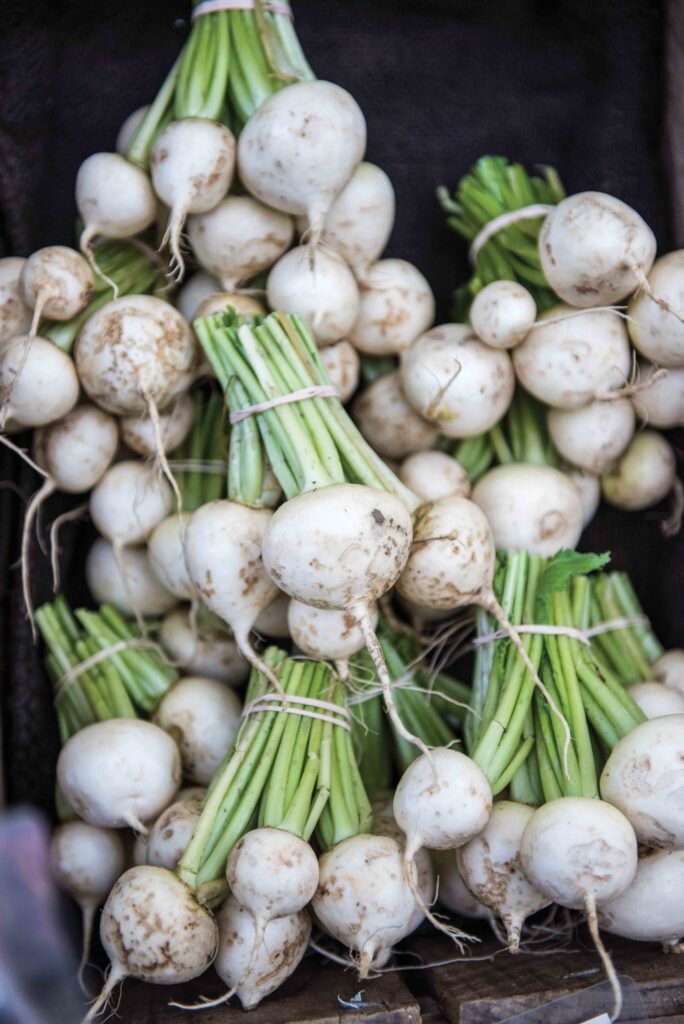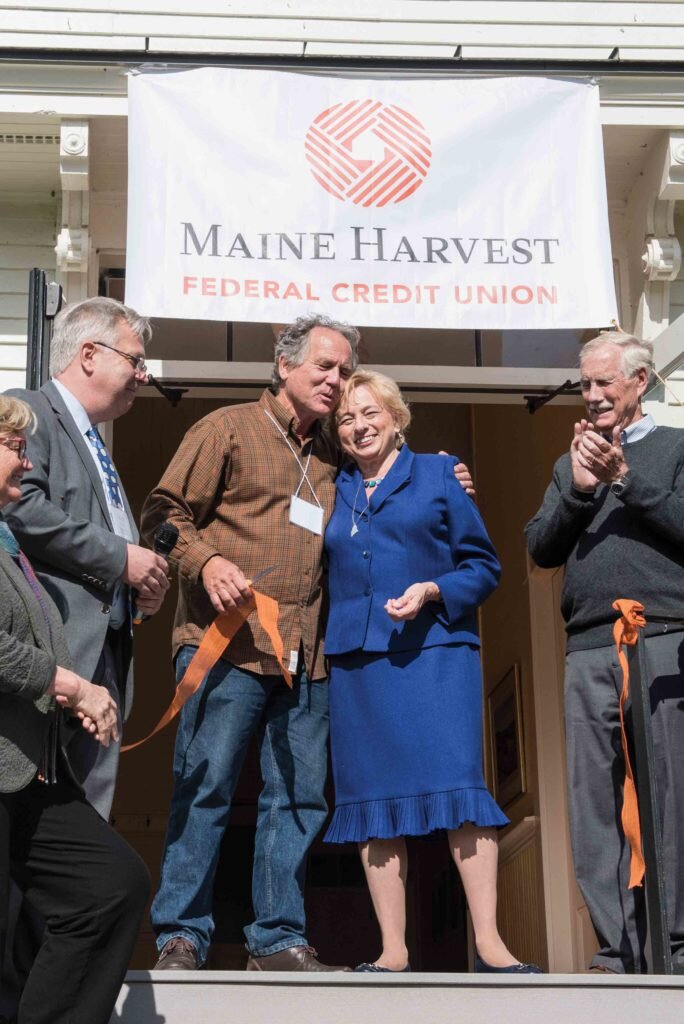Mainers Funding Mainers
A long, deep furrow connects Maine farmers to friendly finance at a new credit union.
Issue: January 2020
By: Phillip Conkling
Photography by: Kelsey Kobik
s a 12-year-old, Sam May ran a manure spreader at Cripps Dairy Farm on scenic rolling hillsides along the Goose River in Rockport. At that time in the 1960s, Rockport still had several dairy farms, locally made ice cream, a successful egg farm, and scores of chicken farms in the surrounding towns. May vividly recalls the day University of Maine Cooperative Extension agents convinced Chet Cripps to convert his dairy farm to a golf course. “On fields where we once spread manure,” May says, “they now spread Roundup, a probable carcinogen. What did we gain?”
Simple, searing experiences from childhood have a way of inhabiting us well into adulthood, and May didn’t forget the loss of the dairy farm. In 2011, after an extensive career as a financial analyst in Boston, Silicon Valley, and Hong Kong, May returned to Maine and was impressed by the nascent sustainable food movement, which had started to affect the way Maine people were shopping and eating. May joined the board of the Maine Organic Farmers and Gardeners Association (MOFGA), which had a strong track record of helping attract and support new farmers in Maine who were beginning to reinhabit and rejuvenate old farms. One of MOFGA’s most successful programs brokers season-long apprenticeships between young would-be farmers and Maine’s growing network of organic farms.
Curly kale, bunched and packed for delivery.
In 2012, during the last year of his life, MOFGA’s charismatic leader Russell Libby identified a critical piece that was missing from the complex puzzle of rebuilding a stable, productive farm economy in Maine. Libby had long chafed at existing federal farm finance programs that were primarily aimed at helping large farms growing commodity crops like potatoes and blueberries. In order to increase the flow of capital to new farmers starting to supply the locavore market, Libby, in his last public appearance, called for the establishment of a credit union to enable Maine’s new farms to grow and thrive. May decided to take on the challenge because he deeply admired Libby’s understanding of “the way money intersects with reality.” May recalled how Libby promoted local organic food by showing how spending five dollars a week on Maine food could improve the local farm economy. “He did the spreadsheet work to show what that would mean, and that was right down my alley,” says May.
Around a decade earlier, 22-year-old Beth Schiller had started her farming life as an apprentice in a program to place prospective farmers on cooperating farms so they could understand the hard realities of the work—and the rewards involved. Schiller, who grew up in Readfield, studied science at college and thought she might go into medicine. But Maine pulled her back, and she decided that she wanted a life where what she did for work would be connected to where she lived—and both would be connected to what she ate. Without any experience but with an appetite for learning, Schiller decided to become a farmer. Her friends were not surprised. When she was growing up, as she put it, “Girls were into horses, but I was into sheep.”
Schiller harvests lemon bergamot to sell at the Portland Food Co-op.
Her early years as an apprentice were followed by managing the garden at the Chewonki farm in Wiscasset, and then Schiller started Dandelion Spring Farm on leased land in Union. She started with vegetables as a base and a small flock of sheep and a dairy cow. Schiller recognized that no bank was going to loan her money to enable her to expand her small farming business. She was going to have to bootstrap her way into farming without access to any financing other than what she could set aside from her own sales. Through Maine FarmLink, a Maine Farmland Trust service that connects prospective farmers with farmland owners, Schiller met a man from Chicago who had gone to a summer camp in Washington, Maine, as a boy and owned land there. He agreed to rent her his farmland in Washington on favorable terms, and she expanded Dandelion Spring Farm into a mixed farming operation raising vegetables, sheep, and pigs.
Year by year Schiller added loyal customers, but she longed to own a farm of her own, and the Washington farm she was leasing was not for sale. In her early 30s, Schiller moved her farming operation to a new location in Newcastle from which she could supply farmers’ markets in both Rockland and Portland and also start selling to an ever-increasing number of Portland chefs who prized her locally grown, organic produce and herbs. But Newcastle was not Schiller’s “forever farm.”
Sam May, who helped create Maine Harvest Federal Credit Union, chooses salad greens from the Dandelion Spring Farm booth at the Portland Farmers’ Market in Deering Oaks Park.
In 2011 when Sam May began researching how to start a credit union, he knew his way around the world of finance. He once did a $650 million early telecommunications deal, he says, “that took a week.” How hard could it be to put together the required capital to start a new credit union for Maine farmers? He was about to find out.
Credit unions have existed in the U.S. since 1909 and have had a well-defined regulatory frame-work since 1934, when President Franklin Roosevelt signed the Federal Credit Union Act into law. With his financial background, May believed that a credit union for Maine farmers was “exactly the right tool to use.” He would not need to invent anything new because credit unions could mobilize capital to help revitalize and relocalize Maine’s food economy. Moreover, credit unions are exempt from federal taxes and do not pay dividends to shareholders, so they can afford to lend at lower rates. And finally, starting a bank requires $25 million in capital, but a credit union requires “only” $2.4 million to get off the ground.
Six years ago, Scott Budde, a bank stock analyst for the giant investment firm of the Teachers Insurance and Annuity Association of America (TIAA) in New York City, had just been tasked with researching a new social and community investing portfolio for the company, including identifying investment opportunities in such sectors as sustainable farming. But during his initial research, Budde recognized an immediate problem. While TIAA was looking to make big investments, that strategy did not match the needs of most new farmers. One of Budde’s initial contacts, however, worked for the John Merck Fund, and was interested in his work. The fund, which supports efforts to improve human health and the environment, was impressed enough with Budde’s background to make a grant to enable him to extend his research into a farming-oriented credit union for a year.
As Budde began zeroing in on the geographic area a credit union might serve, he initially considered a large region—New England combined with New York and New Jersey—but he soon realized that area was too big to get his arms around. On the other hand, some farmers wanted a credit union that would be narrowly focused, such as “a lower Hudson Valley goat farm credit union,” Budde recalls. Ultimately Budde recognized an effective credit union would depend on strong local partners. “I needed to work with someone who knew the area.” Budde found prospective partners in Maine Farmland Trust, run then by John Piotti, and MOFGA, led by Russell Libby, which had 40 employees between them. It also impressed Budde that “both Libby and Piotti returned my phone calls.”
May first met Budde six years ago at the Common Ground Fair, one of the centers of the resurgence in Maine farming, where he was circulating a questionnaire as part of his John Merck Fund research. They hit it off. Within four months, Budde had quit his job and moved to Monument Square in Portland. May recalls thinking at the time, “Dude, wait, we don’t have any money.”
May and Budde were the ultimate Mutt and Jeff team, with complementary skill sets. May had a strong entrepreneurial streak but was also grounded in Maine communities and Maine ways, while Budde had “never seen a complex form he didn’t want to fill out,” according to May. Their partnership required all of their joint talents and more. The application they submit-ted to the National Credit Union Administration was 1,075 pages long.
U.S. Representative Chellie Pingree, Budde, May, Governor Janet Mills, and U.S. Senator Angus King celebrate the October opening of the Maine Harvest Federal Credit Union on the steps of its new building in Unity.
May and Budde were the ultimate Mutt and Jeff team, with complementary skill sets. May had a strong entrepreneurial streak but was also grounded in Maine communities and Maine ways, while Budde had “never seen a complex form he didn’t want to fill out,” according to May. Their partnership required all of their joint talents and more. The application they submit-ted to the National Credit Union Administration was 1,075 pages long.
May and Budde were the ultimate Mutt and Jeff team, with complementary skill sets. May had a strong entrepreneurial streak but was also grounded in Maine communities and Maine ways, while Budde had “never seen a complex form he didn’t want to fill out,” according to May. Their partnership required all of their joint talents and more. The application they submit-ted to the National Credit Union Administration was 1,075 pages long.
May and Budde were the ultimate Mutt and Jeff team, with complementary skill sets. May had a strong entrepreneurial streak but was also grounded in Maine communities and Maine ways, while Budde had “never seen a complex form he didn’t want to fill out,” according to May. Their partnership required all of their joint talents and more. The application they submit-ted to the National Credit Union Administration was 1,075 pages long.
In 2017 Beth Schiller’s farming operation was thriving, and she started looking for farmland to buy—a big step for a self-made farmer who had financed the growth of her farming business herself. Farm Credit East, a federally sponsored entity that lends to farmers throughout the Northeast and New England, didn’t have a category for the kind of intensive, organic farm-to-table operation that Schiller had grown into an annually profitable operation. One government credit analyst referred to Schiller’s business as a “farmette” because of its smaller size compared to commercial farms elsewhere in the country. Although Schiller’s farm had been profitable for 16 years and it was still small, compared with potato farms in Aroostook County or blueberry fields along the coast, putting the financing together was a huge struggle.
Scott Budde, who also helped create Maine Harvest Federal Credit Union, and May meet at the Portland Farmers’ Market.
As part of Farm Credit East’s approval of a mortgage for Schiller to buy a productive 80-acre piece of farmland in Bowdoinham, Schiller sold an agricultural easement to Maine Farmland Trust that permanently protects the land by restricting its use to farming. Schiller recalls thinking to herself, “It shouldn’t be this hard.” Or as May puts it: “The system should want her to grow her business.” He believes that Farm Credit East, like many federal farm programs, “is a captured entity for the benefit of large players.”
While May continued to act as a liaison to Maine farmers, Budde began crafting business plans, procedures, policies, loan documents, and contracts with vendors for the institution they planned to call Maine Harvest Federal Credit Union. “There’s no amount of bureaucratic bull-shit I can’t handle,” Budde says. While Budde was dealing with the nearly endless paperwork, May was beating the bushes to raise the $2.4 million in capital plus annual expenses required to receive a charter from the National Credit Union Administration. Maine-based foundations, including the Maine Community Foundation, Elmina B. Sewall Foundation, and Quimby Family Foundation among others, put up approximately half of the capital, and several individuals made significant contributions. Ultimately 70 percent of the funds came from Maine, but it took a grueling six and a half years.
On this crisp fall day in October of 2019, virtually all Maine’s resurgent farm leaders, along with three-quarters of the state’s congressional delegation and Governor Janet Mills, have showed up for the ribbon cutting at the new headquarters of Maine Harvest Federal Credit Union in Unity. Anna Eleanor Roosevelt, the granddaughter of Franklin Delano Roosevelt, makes the ceremonial first deposit. “Many people don’t realize that my grandfather came from a farming family in the Hudson River Valley,” she says. “He understood how important financing could be for reestablishing America’s farming economy after the devastation of the Dust Bowl. Signing the National Credit Union Act had a deeper meaning to him. It was a personal act.”
Looking around the crowd in the dooryard of the former schoolhouse that has found its new life as the credit union headquarters, it’s encouraging to see how many different institutions, leaders, and farmers came together to make the Maine Harvest Federal Credit Union a reality. Decades ago, when many of these farm leaders began working to resurrect Maine’s farm economy, no one would have predicted that Maine would become a national leader in attracting young farmers to rework productive farmland. Every consumer who buys local produce has contributed to this vital under-pinning of Maine’s farm economy. In spite of the daunting challenges that confront those working on Maine farms, Schiller expresses a vision everyone involved in the impressive resurgence of Maine farming can embrace: “Mainers feeding Mainers,” she says. “We can totally feed ourselves year-round.” Leveraging the power of credit to help farmers and food producers grow, Budde and his staff at Maine Harvest Federal Credit Union will bring Maine closer to reaching this visionary goal.
This article was originally published by maine. magazine. Maine Media Collective © 2020

